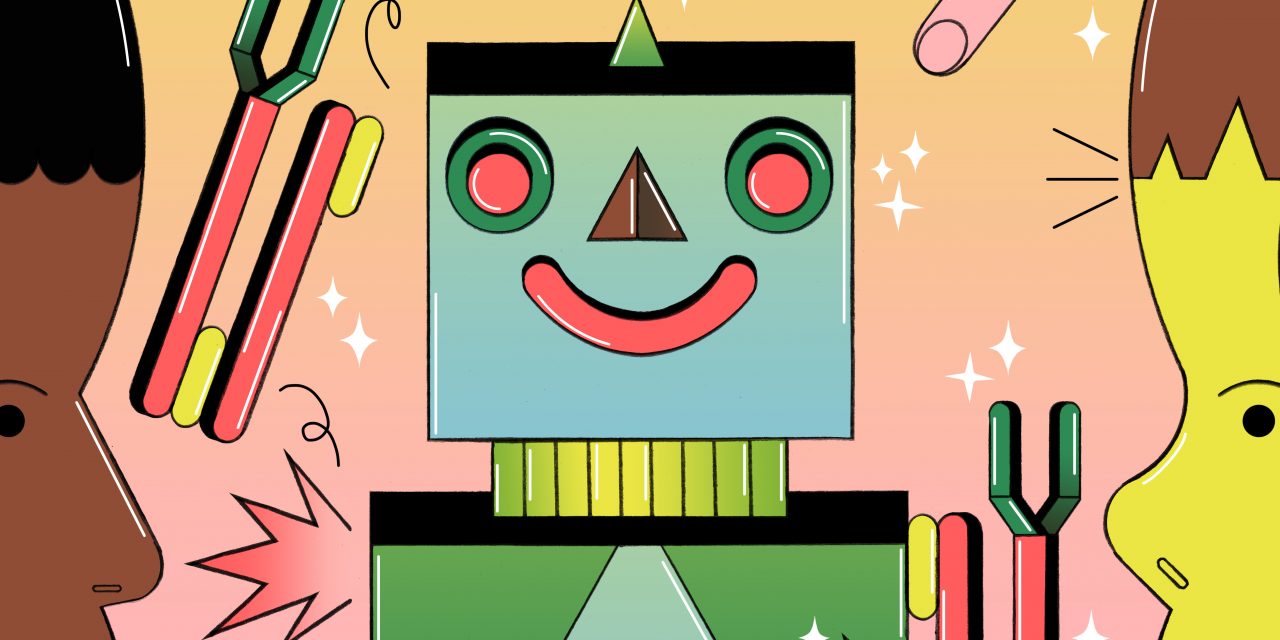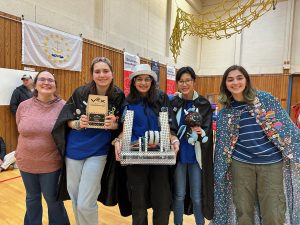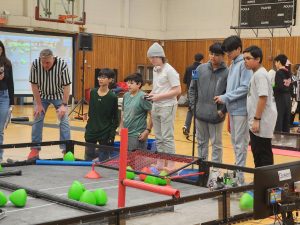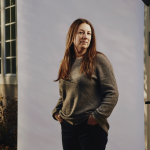
The Long Picture

Robotics coach Bridget Sitkoff believes the lessons learned on the Middle School robotics team extend well beyond the middle school years.
Story by Sarah Abrams
Illustration by Moritz Weinert
Twice a week during the school year an enthusiastic group of middle schoolers meet up in a large open space on the ground floor of the Art and Media Center. They come together at the end of the school day in a room filled with sheets of metal, gears, and tubes to build robots they hope will compete successfully in VEX Robotics competitions held across New England in the coming months.
“That’s a big commitment for a young student,” says Bridget Sitkoff, coach of the Middle School’s robotics team and the Middle School’s computer science teacher. “After a long day, they choose to spend another hour and a half at school. Opting into this, you have to care about it.”
Eighth-grader Ella Freeman ‘29 couldn’t be happier about the time she spends as a member of the team. “I love the problem-solving aspect of robotics—being able to engineer your own solutions to different problems and improve upon your design throughout the year,” she says. In addition to the after-school meetings, the students attend qualifying events and tournaments on weekends through the fall and winter.
The youngest on an all-girls team last year, Freeman loved how her teammates made her feel comfortable. “I’ve learned a lot about teamwork and about how to make the best possible robot through how you build the specific robot itself,” she says. “There are so many different possibilities: different metals and the kinds of building and attachment methods you can use. What you do with your robot can change the overall design and how it operates.”

Sitkoff is proud of the team’s enthusiasm, determination, and accomplishments. Each year the team has qualified for the Middle School New England Championships. And just as important, she says, are the skills and independence they gain as they prepare for high school and beyond.
“The students’ first robots are of- ten lessons in persistence,” Sitkoff says. “It’s not at all unusual for the robots to break and stop working in the middle of a game. During tournaments, the students will hear ‘Get that robot off the field’ because it’s dropping parts as it drives around. They won’t hear anyone say, ‘OK, you win anyway.’ They hear ‘Get that off the field and try again.’ And the students figure out they have the resilience to do that. Years later, those same kids go to the Robotics World Championships.”
“I love it when they win because it makes them happy,” Sitkoff says, “but it’s that long picture that I also care about. If you figure out when your robot breaks down that you don’t need an adult to fix it for you, then you’re going to win when you’re 16. You don’t have to win when you’re 12.”
An important feature of the program is that the Middle and Upper School teams occupy the same space. Sharing the space—set up for each team’s VEX robotics game—is a great advantage for both groups, says Sitkoff. It’s a unique opportunity for students from the two schools to interact. The older students enjoy helping out their younger counterparts. “They will often show up at the younger students’ tournaments,” she says. “You look up in the bleachers and there’s our Upper School team.”
The Upper School leadership is huge. Sitkoff says: “When the younger students see these older students who have worked with them and tell them stories about how hard it was when they were younger, and then they see them going to the World Championships, that means a lot. When we streamed the older students competing in the regionals last year, the middle schoolers were here every day at lunch. It was really lovely.”
Twelfth-grader Joey Mussali ‘25, a member of the Upper School robotics team, believes his participation as a middle schooler was essential as he moved up to the Upper School. “Exposure in those early years helps get all those moments out of the way when you’re just learning about the design process,” he says. It’s a great introduction.”
Last spring, the Upper School robotics program, coached by Chris Hales, sent two teams to the World Championships in Dallas, where they qualified for the quarter finals. Two banners recognizing design and robots—won last year at the Southern New England Regionals— hang on the robotics room wall.
Sitkoff and Hales are pleased to see participation in the program grow—in both size and diversity. The two are committed to making sure that Milton’s robotics program is seen as open to everyone. “Chris and I have worked really intentionally to try to make this happen,” Sitkoff says. “There are a lot of all-male robot teams, but that’s not at all who we want to be.”
Both Hales and Sitkoff are starting to see the results of their efforts. “We’re starting to build a reputation as a program that welcomes kids from diverse backgrounds and identities,” Sitkoff says. “We’re hearing that students are coming on tours and applying because of the program’s inclusivity, which is great. We want to be there for those students who might be wondering ‘How can I be in a technology and engineering space and have my identity feel welcome?’ If we can be that place, Chris and I would be delighted.”




